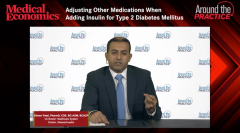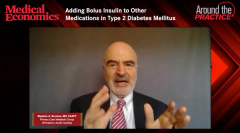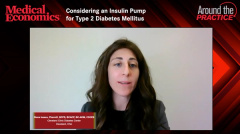
Adding Bolus Insulin to other medications in Type 2 Diabetes Mellitus
Episodes in this series

Dhiren Patel, PharmD, CDE, BC-ADM, BCACP: Talk to me about the landscape change that we’re seeing. It may be a smaller percentage of those patients because you have some of the advents of these other classes, but what percentage of patients are you seeing with type 2 diabetes who still need to be on a basal bolus insulin therapy?
Stephen A. Brunton, MD, FAAFP: With basal bolus insulin, it has been overly intimidating to many of my colleagues. Thinking after starting, you basically go from a basal insulin to insulin 4 times a day. There is a more logical way that works well, which is to start with 1 bolus dose a day with the largest meal to deal with the largest glucose excursion. And if it’s necessary, then go to twice a day and then finally 3 times a day.
As you mentioned, there has been a bit of an evolution. The use of a GLP1 agonist either in the combination agents or frankly as an add-on at first has been able to give us a way of controlling this with less likelihood of hypoglycemia. We certainly have a lot of patients on basal bolus insulin, but when you have access to a GLP1, that has taken some of the basal bolus marketplace and given a degree of comfort to me and my colleagues.
Robert Busch, MD: Right. We feel the same way. As Stephen mentioned, you have some combinations like basal insulin and GLP together. If the patient can afford that, it’s still the 1 shot, but they’re getting free bolus insulin when they’re upping their basal insulin without hypoglycemia from the GLP. I then do the exact same thing: I never start someone with type 2 diabetes on 4 shots a day, or they’ll put their shoes and socks on, run away, and never come back. I’ll do this, which you do as well: Once they’re on basal insulin, giving the second injection is not that terrible. Giving 3 additional injections is a bigger deal, so I do the exact same thing.
I try to ask them. I say, “We played Sherlock Holmes, and we fixed the fasting sugar. Let’s look at after which meal you’re highest and start with a rapid-acting insulin before that meal and do the same thing.” We’ll try to get the 2-hour readings down to the goal at 140, 160 mg/dL, or whatever that goal would be.
Dhiren Patel, PharmD, CDE, BC-ADM, BCACP: It seems as if we’ve all at least cheated that first shot, and then we may get that second shot on board with the largest meal that they’re doing. We’re trying to mimic physiologic insulin production, so there are some patients for whom we are going to have the potential for 4 shots a day. What are some of the concerns that surface in those situations where you know a patient truly needs a basal bolus insulin, and you’re at 3 to 4 shots a day.
Diana Isaacs, PharmD, BCPS, BCACP, BC-ADM, CDCES: That becomes more challenging. People need it, so 1 of the challenges is getting used to carrying that insulin all the time. I can’t tell you how many patients I have who are on the multiple daily injections. They then come to my office when it’s around lunchtime, and I know they’re going to go eat. I ask, “Do you have your insulin with you?” Then they don’t have it with them, or they don’t even have their meter with them.
That is a real barrier, and with that more intensive insulin dosing, we also do need more of that monitoring. For many patients, we don’t just give them a set dose, but we might even give them a correction factor. Let’s say their glucose is a bit higher: They can add some insulin, and that adds another layer of complexity because we’re asking them not only to carry their insulin and find a discreet place to take it but also to do these calculations in their head and monitor their glucose to make sure they’re not going too low or too high. We are asking for a lot. It’s a lot to do.
Stephen A. Brunton, MD, FAAFP: You then add onto that carbohydrate counting. People don’t estimate their meals very well, so they’re chasing their glucose half the time. We ask a lot of our patients with diabetes. We need to get some humility in that interaction with the patient.
We [at the Primary Care Metabolic Group] run a conference for chief residents in family medicine on diabetes, and we make them act like they have diabetes. They have to count carbohydrates. They wear pumps, and they have to give themselves insulin when appropriate. They get a sense of recognition of how challenging diabetes can be. Diana, you pointed out all these things we ask patients to do, and it’s no wonder that patients feel overwhelmed. That’s where we can develop a partnership with them and ask them about it. When patients with diabetes come in, I don’t say, “How are you doing?” I say, “What’s the biggest challenge you found in the last week or 2 in the management of diabetes?” That way, we can at least focus our attention into the challenges they’re facing.
Dhiren Patel, PharmD, CDE, BC-ADM, BCACP: I agree. I may be trying to think of a multivitamin or 1 pill a day, and I forget that. When I’m doing a medication recommendation, it’s crazy to me that someone is doing that. I think, “Wow. These are all the things you need to do, and then an addition to some of that.” What’s nice, and we’re going to talk about that in a little bit, is the introduction of diabetes technology. I’m hoping this continues to get elevated. This burden we’ve been putting on the patients may shift to the devices a little more. That’s not to say that it’s going to affect everything. Steve, you’re absolutely right. It is a lot. You make the laundry list of it all: Did you check your feet? Did you do this? Did you do this? Make sure you carry your glucagon. There is a lot, and people are then overwhelmed and then don’t want to do anything. All those things are important to keep in mind, so thank you all.
Newsletter
Stay informed and empowered with Medical Economics enewsletter, delivering expert insights, financial strategies, practice management tips and technology trends — tailored for today’s physicians.











